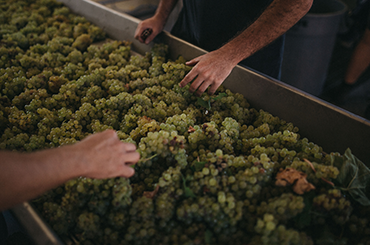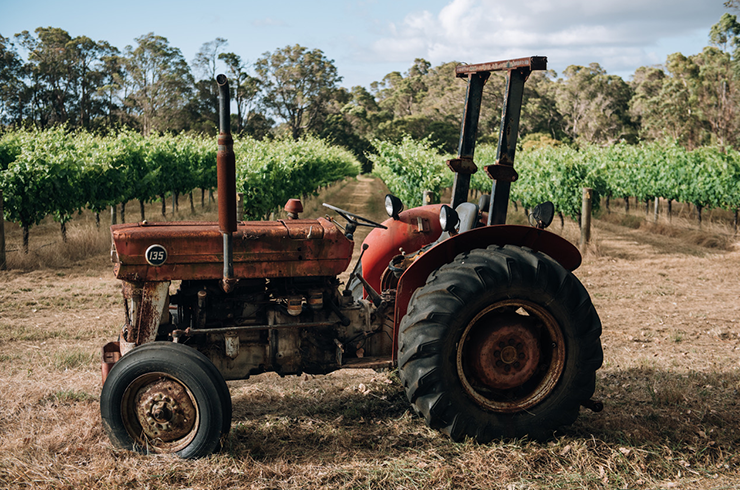Chenin blanc is not a variety that can be easily summed up. After a history of mass production in blends, its reputation is ripe for resurgence by the way of hand-crafted, single variety styles from some of the country's most exciting names. This chameleon grape is now finding a home with boutique winemakers who use it as a blank canvas for terroir and technical ability – we chat to three of them here.

H. What do you love about chenin blanc?
R. Its versatility. It is impossible to describe or narrow down chenin blanc in terms of flavour because it is ultimately a blank canvas – it can be about anything you want it to be and be great in any mode. Whether it expresses a winemaker’s ego, the site where it’s grown or the process used to make it, chenin can do it all and in any style. However, if I had to try to sum up Australian chenin blanc at this moment in time, I would describe is as exploratory, vital and unconquered.
H. How do you approach the winemaking process?
R. My wines are about site and subregion, not me or any of my proclivities. I try and capitalise on the whole grape, employing solids judiciously and seeking the flavour, texture and unique vineyard character locked away within them. I started off using a lot of skins in my ferments, essentially pushing the limits in order the find the edge of the spectrum and within the resultant chaotic funk, I found myself seeking elegance instead of raw, extreme appeal. I have essentially come full circle, ending up very close to where I began as a younger winemaker: loving and seeking classicism – only now I am there of my accord instead of being told to be there.
Find out more.

H. How would you describe this variety?
J. Australian chenin blanc is made in many different ways, you can’t really pigeon-hole it. Some are off-dry, some are made with lees-contact and wild yeasts, some are made with oak or bottle age, and some (like ours), are made into sparkling wine – it’s an incredibly versatile variety. The first chenin blanc wines I tried were aged varieties from the Swan Valley. Drinking examples with 15-20 years bottle-age was just incredible. I couldn’t believe wines were being made this way that were being compared to aged semillons from the Hunter Valley.
H. What is unique about your product and how it is made?
J. Our chenin is a single vineyard wine, grown on light, sandy limestone-based soils which add to a clean, fresh acid line. Rather than big, broad heavy soils, our lighter soils give a lighter texture to the wine which is an attractive trait. Following ferment, I often leave on fermentation lees to fill out the palate; I prefer very minimal residual sugar. In recent years, our summers have become wetter, so we are definitely picking earlier and trying to retain that good natural acidity in the fruit – that is a key winemaking consideration for us.
Find out more.

H. How would you characterise Australian chenin blanc?
G. Australian chenin blanc is on the rise, it’s being re-invented. It is both fortunate and unfortunate that high-yielding chenin blanc was historically used in large commercial wines – unfortunate as we need to recover from that reputation, but fortunate because we now have access to 30-plus year old vines across a variety of terroir and winemakers are now making wonderful wines from them. It’s an ancient variety that has been a little forgotten, but it is so versatile and capable of greatness in dryness, lusciousness and bubbles.
H. Can you explain your process?
G. At Vino Volta, we make light-to-medium bodied, interesting and textural wines. Most of our products are made with natural fermentation; one of our chenin styles suits inoculation. We are among the first in Western Australia to focus on warm-climate chenin – we try to pick just on the cusp of ripeness to ensure vibrancy. One of our focuses is to get Chenin truly recognised as a super versatile grape capable of making a wide range of tasty, age-worthy wines. Each time we make a new wine, there is a lot of research, reading, talking, tasting and vineyard walking, then we might tackle the winemaking a little differently to get our expression right.
Find out more.
This article was produced in partnership with the featured wineries.
Top image credit: Wine Australia

Winemaker Remi Guise in the tripe.iscariot barrel room.
Remi Guise, tripe.iscariotH. What do you love about chenin blanc?
R. Its versatility. It is impossible to describe or narrow down chenin blanc in terms of flavour because it is ultimately a blank canvas – it can be about anything you want it to be and be great in any mode. Whether it expresses a winemaker’s ego, the site where it’s grown or the process used to make it, chenin can do it all and in any style. However, if I had to try to sum up Australian chenin blanc at this moment in time, I would describe is as exploratory, vital and unconquered.
H. How do you approach the winemaking process?
R. My wines are about site and subregion, not me or any of my proclivities. I try and capitalise on the whole grape, employing solids judiciously and seeking the flavour, texture and unique vineyard character locked away within them. I started off using a lot of skins in my ferments, essentially pushing the limits in order the find the edge of the spectrum and within the resultant chaotic funk, I found myself seeking elegance instead of raw, extreme appeal. I have essentially come full circle, ending up very close to where I began as a younger winemaker: loving and seeking classicism – only now I am there of my accord instead of being told to be there.
Find out more.

Third generation winemaker, Jason Conti.
Jason Conti, Paul Conti Wines H. How would you describe this variety?
J. Australian chenin blanc is made in many different ways, you can’t really pigeon-hole it. Some are off-dry, some are made with lees-contact and wild yeasts, some are made with oak or bottle age, and some (like ours), are made into sparkling wine – it’s an incredibly versatile variety. The first chenin blanc wines I tried were aged varieties from the Swan Valley. Drinking examples with 15-20 years bottle-age was just incredible. I couldn’t believe wines were being made this way that were being compared to aged semillons from the Hunter Valley.
H. What is unique about your product and how it is made?
J. Our chenin is a single vineyard wine, grown on light, sandy limestone-based soils which add to a clean, fresh acid line. Rather than big, broad heavy soils, our lighter soils give a lighter texture to the wine which is an attractive trait. Following ferment, I often leave on fermentation lees to fill out the palate; I prefer very minimal residual sugar. In recent years, our summers have become wetter, so we are definitely picking earlier and trying to retain that good natural acidity in the fruit – that is a key winemaking consideration for us.
Find out more.

Garth Cliff at work in the Vino Volta winery.
Garth Cliff, Vino VoltaH. How would you characterise Australian chenin blanc?
G. Australian chenin blanc is on the rise, it’s being re-invented. It is both fortunate and unfortunate that high-yielding chenin blanc was historically used in large commercial wines – unfortunate as we need to recover from that reputation, but fortunate because we now have access to 30-plus year old vines across a variety of terroir and winemakers are now making wonderful wines from them. It’s an ancient variety that has been a little forgotten, but it is so versatile and capable of greatness in dryness, lusciousness and bubbles.
H. Can you explain your process?
G. At Vino Volta, we make light-to-medium bodied, interesting and textural wines. Most of our products are made with natural fermentation; one of our chenin styles suits inoculation. We are among the first in Western Australia to focus on warm-climate chenin – we try to pick just on the cusp of ripeness to ensure vibrancy. One of our focuses is to get Chenin truly recognised as a super versatile grape capable of making a wide range of tasty, age-worthy wines. Each time we make a new wine, there is a lot of research, reading, talking, tasting and vineyard walking, then we might tackle the winemaking a little differently to get our expression right.
Find out more.
This article was produced in partnership with the featured wineries.
Top image credit: Wine Australia






